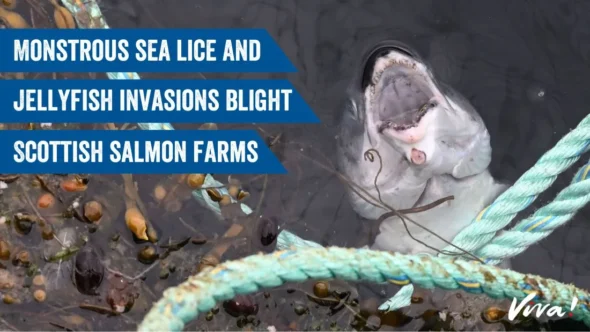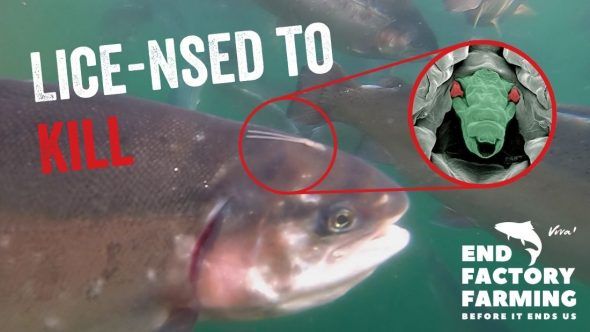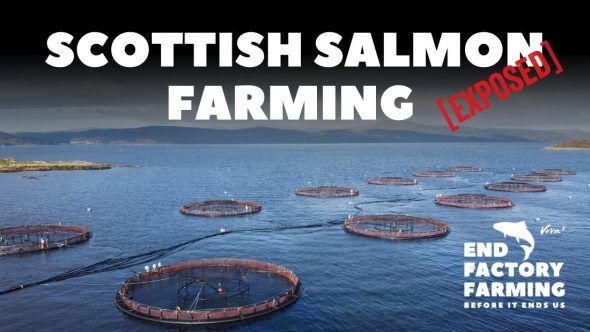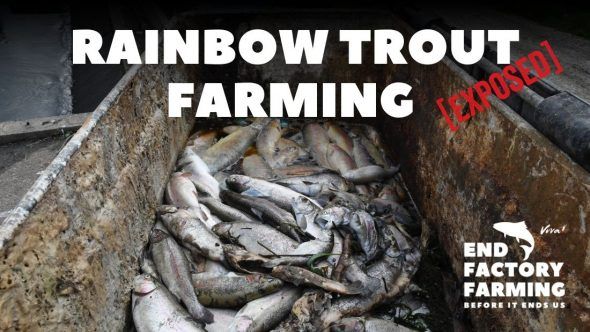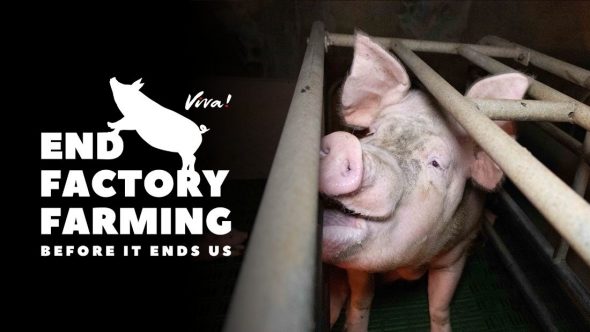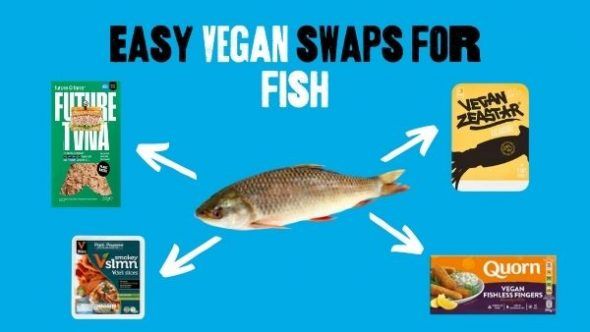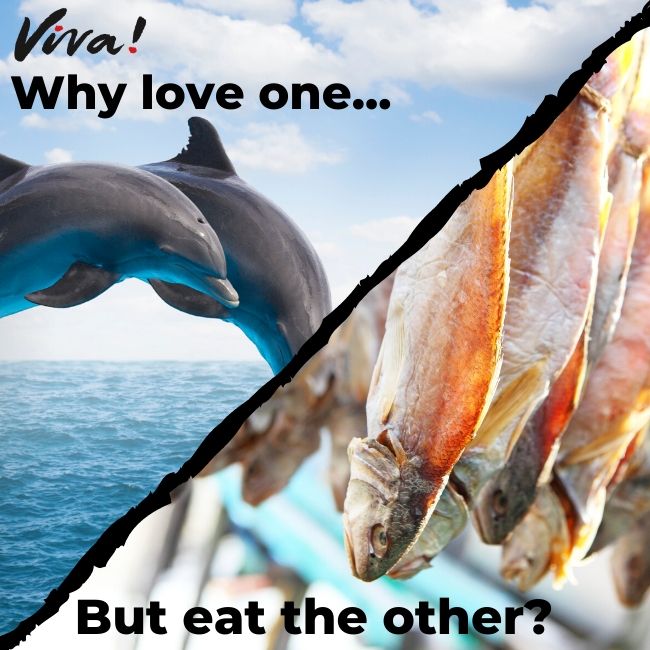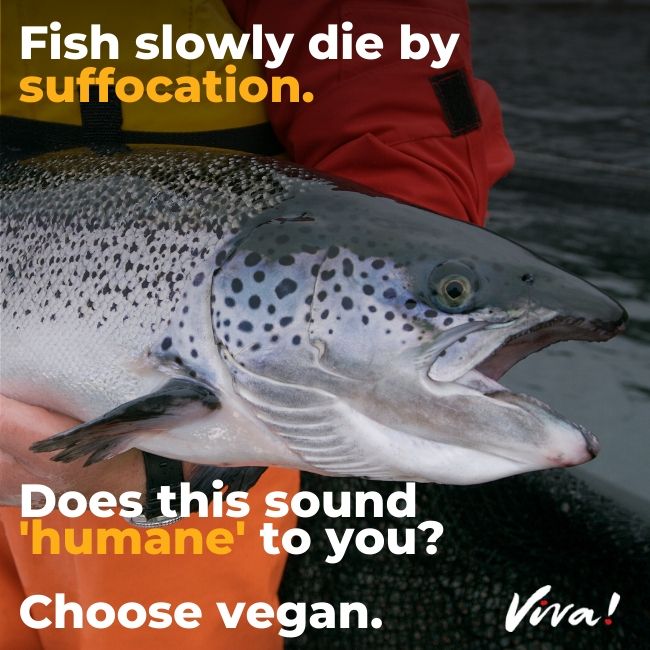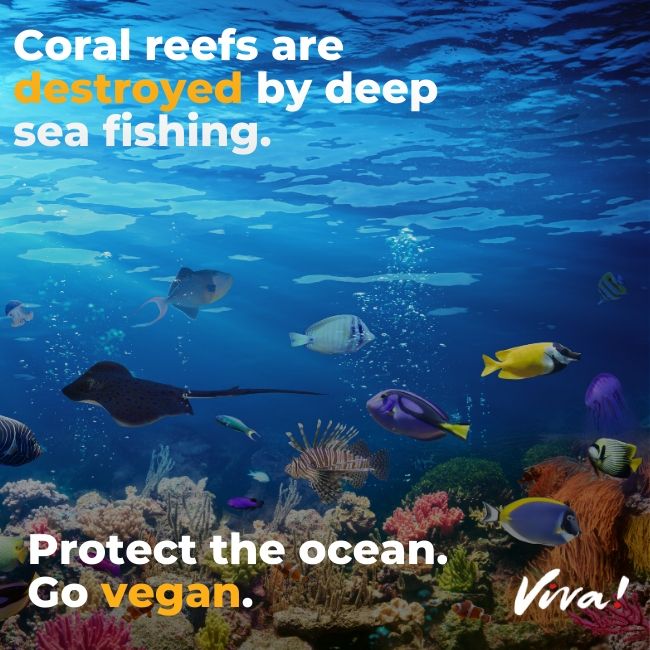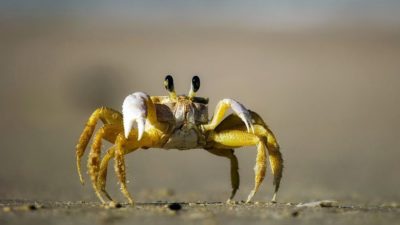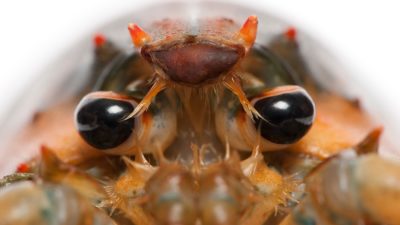Fish

- Clownfish are hermaphrodites and able to change sex. When the female at the top of the hierarchy dies, the most dominant male changes sex and takes her place.1Casas, L., Saborido-Rey, F., Ryu, T., Michell, C., Ravasi, T. and Irigoien, X., 2016. ‘Sex Change in Clownfish: Molecular Insights from Transcriptome Analysis’. Scientific Reports 6 (35461). Available at https://www.ncbi.nlm.nih.gov/pmc/articles/PMC5066260/ [Accessed 21 April 2020].
- Several types of fish cooperate when they hunt. One interesting example is the grouper and the eel, who use signals and gestures to communicate their desires or intentions and help each other catch prey.2Balcombe, J., 2016. What a Fish Knows: The Inner Lives of our Underwater Cousins. US: Scientific American.
- Bluestreak cleaner wrasse are most well-known for their strange feeding habits. They eat parasitic copepods (tiny crustaceans) and the diseased tissue of larger fish by entering their mouths and gill openings.3Mehta, S., 2019. ‘Where do Fish go for a Spa?’ Mongabay 26 July. Available at https://india.mongabay.com/2019/07/where-do-fish-go-for-a-spa/ [Accessed 21 April 2020].
- The largest fish in the world is a shark – specifically, the whale shark – which grows to more than 20 metres long (approximately the length of two buses) and may weigh several tonnes. They largely eat plankton by what is known as ‘filter feeding’ but have over 4,000 3mm length teeth!4National Oceanic and Atmospheric Administration (NOAA), 2019. ‘Fun Facts about Fascinating Fish’. Available at https://www.fisheries.noaa.gov/national/outreach-and-education/fun-facts-about-fascinating-fish [Accessed 21 April 2020].
- Bluefin tuna are called the ‘tiger of the sea’, due to their power and voraciousness. In 2019, a single fish sold at a Tokyo fish market for £2.5 million and weighed a staggering 278 kgs.5Telegraph Reporters, 2019. ‘Tuna sells for record $3 million in auction at Tokyo’s new fish market’. The Telegraph 5 January. Available at https://www.telegraph.co.uk/news/2019/01/05/tuna-sells-record-3-million-auction-tokyos-new-fish-market/ [Accessed 28 April 2020].
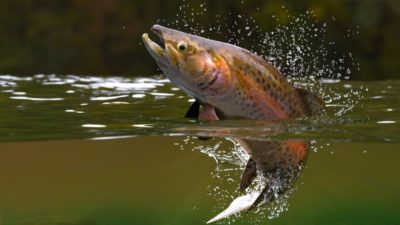
- Antarctic toothfish, otherwise known as Chilean sea bass on restaurant menus, are large, deep-sea predatory fish, found only in the ice-laden Southern Ocean. To survive in sub-freezing temperatures, they have evolved a slow heartbeat – one beat every six seconds – and have developed special proteins in their bodies that act like anti-freeze to prevent their blood from freezing.6Brooks, C., 2008. ‘Studying Antarctic Toothfish and the Special Proteins in their Bodies that help them Thrive in Subfreezing Waters’. Ice Stories: Dispatches from Polar Scientists 03 November. Available at http://icestories.exploratorium.edu/dispatches/antarctic-projects/antifreeze-fish/index.html [Accessed 21 April 2020].
- Cod are prized for the whiteness of their flesh. This white muscle tissue is formed in fish that are suspended in the sluggish near-weightless ocean environment. They are not for strength but for quick action – the burst of speed with which a slowly-cruising cod, will use to suddenly pounce on its prey.7Kurlansky, M., 1999. Cod: A Biography of the Fish that Changed the World. London: Vintage Books.
- Some fish species can live in both freshwater and saltwater. Salmon are ‘anadromous euryhaline’ fish, which means they are born in freshwater but spend most of their lives in the sea, only returning to the freshwater streams where they were born to spawn.8Melina, R., 2012. ‘Can Saltwater Fish Live in Fresh Water?’. Live Science 28 September. Available at https://www.livescience.com/32167-can-saltwater-fish-live-in-fresh-water.html [Accessed 21 April 2020].
- Lungfish can live out of water for several years. They have both gills and a lung, secrete a mucus cocoon and burrow themselves under unbaked earth. Lungfish take in air to their lung through a built-in breathing tube that leads to the surface.9Head, H., 2008. Amazing Fish (Amazing Life Cycles). New York: Gareth Stevens Publishing.
- A small goby fish can memorise the topography of a tidal pool in one go by swimming over it at high tide – a feat few, if any, humans could achieve.2Balcombe, J., 2016. What a Fish Knows: The Inner Lives of our Underwater Cousins. US: Scientific American.
- Coral-crunching parrotfish excrete an average 90 kgs of sand each a year by pulverising chunks of reef with their grinding teeth to access the algae-filled polyps inside. For people living on low-lying atolls, such as Pacific Islanders, this excreted sand is considered a life-saving land biomass.10Field, M., 2014. The Catch: How Fishing Companies Reinvented Slavery and Plunder. New Zealand: AWA Press.
- On finding a female, males of some deep-sea anglerfish species latch their mouths onto her body and stay there for the remainder of their lives! It doesn’t matter much where they fix their bite – her abdomen or her head – they eventually become fused to her. Many times smaller, the male resembles little more than a modified fin, living off her blood supply and fertilising her intravenously. One female may end up with three or more males sprouting from her body like vestigial limbs.2Balcombe, J., 2016. What a Fish Knows: The Inner Lives of our Underwater Cousins. US: Scientific American.
- Frilled sharks carry their babies for over three years, the longest known pregnancy in nature. They’re one of a few shark species that don’t lay eggs and instead give birth to live young. Litter sizes range between two and 10 offspring.11Tanaka, S., Shiobara, Y., Hioki, S., Abe, H., Nishi, G., Yano, K. and Suzuki, K., 1990. ‘The Reproductive Biology of the Frilled Shark, Chlamydoselachus Anguineus, from Suruga Bay, Japan’. Japanese Journal of Ichthyology 3 (7) pp 273-291. Available at https://www.jstage.jst.go.jp/article/jji1950/37/3/37_3_273/_article/-char/en [Accessed 21 April 2020].

Feature: The Incredible Wild Atlantic Salmon
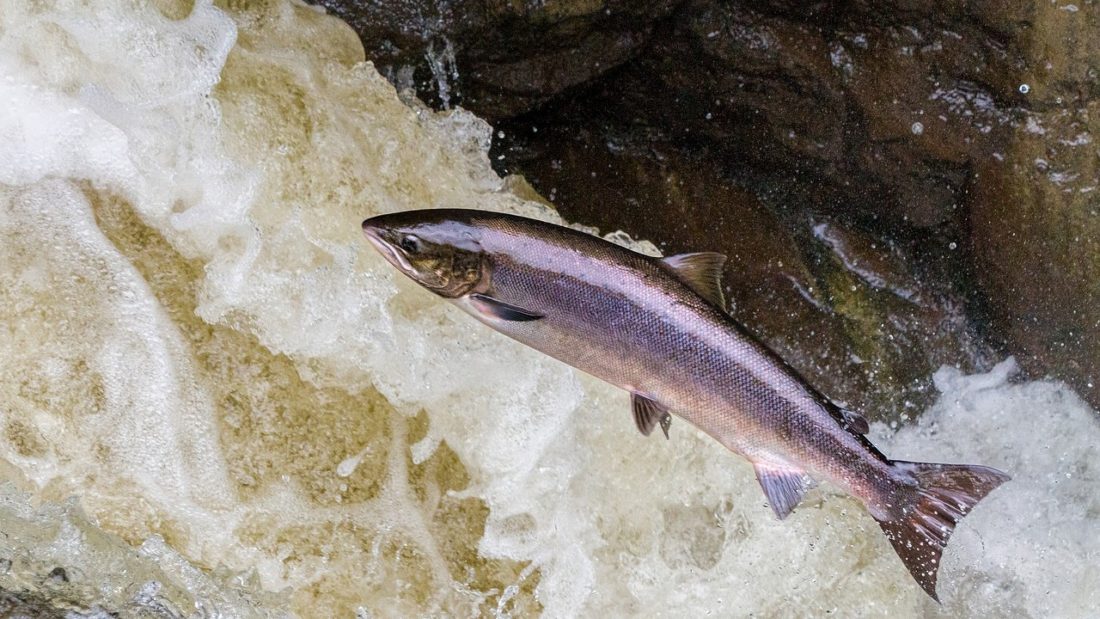
The wild Atlantic salmon is a fish that comes and goes – from river to ocean and back again. Evolved more than 20 million years ago, they’ve been considered a food source for millennia but what they now face is extinction.1BBC Radio 4, 2020. ‘Atlantic Wild Salmon: A Fish Crisis’. The Food Programme 24 February. Available at https://www.bbc.co.uk/programmes/m000fnkv [Accessed 23 April 2020].
As a keystone species central to aquatic biodiversity, salmon are like the canary in the coal mine, telling us that something is going seriously wrong in our oceans.2Bilsby, M. in Allan, V., 2020. ‘Rivers of no return: What’s happened to Scotland’s salmon?’. The Herald 7 March. Available at https://www.heraldscotland.com/news/18288789.fishing-missing-salmon—bids-rescue-wild-fish-stocks/ [Accessed 23 April 2020]. Since the turn of the century, overall numbers of the Atlantic salmon are down by 70 per cent – from around 10 million to between two and three million.3Adams, G., 2020. ‘The wild salmon leaping to extinction: In just ten years, Britain’s premier fishing rivers have seen caches fall from thousands to hundreds. The reason? A toxic cocktail of greed, pollution – and cynical politicians’. Daily Mail 18 January. Available at https://www.dailymail.co.uk/news/article-7901139/GUY-ADAMS.html [Accessed 23 April 2020].
They’re one of several species able to transverse from freshwater to the open sea – where they feed on invertebrates, squid and other smaller fish – before returning to the river where they were born to spawn, using incredible ‘homing’ instincts.
It is thought salmon navigate by using the earth’s magnetic field like a compass. When they find their home river, they smell their way back to the same stretch in which they were born. If they can’t find it, some keep searching until they use up all their energy and die, but most simply try to find other salmon with which to spawn. Ninety to 95 per cent die after spawning; the rest (mainly females) migrate and spawn again.4Scottish Natural heritage, 2020. Atlantic salmon. Available at https://www.nature.scot/plants-animals-and-fungi/fish/freshwater-fish/atlantic-salmon [Accessed 22 May 2020].
Euryhaline is the term applied to organisms that can adapt to a range of water salinities and there are two main types – anadromous and catadromous. Atlantic salmon are the anadromous variety as they migrate from fresh to saltwater environments, but they’re not the only ones. Lampreys, most sturgeon and temperate bass all migrate from the ocean to spawn in freshwater rivers.5Zydlewski, J. and Wilkie, M. P., 2012. ‘6 – Freshwater to Seawater Transitions in Migratory Fishes’ in McCormick, S. D., Farrell, A. P. and Brauner, C. J. (eds.) Euryhaline Fishes 32. London: Elsevier Inc.
It’s thought that from the river, Atlantic salmon travel north towards Norway and spend a summer at sea. Some return home as ‘grilse’, while others continue their migration, heading back after another winter.6Doughty, E., 2019. ‘Atlantic salmon numbers are falling in British rivers — here’s how you can help’. I News 15 October. Available at https://inews.co.uk/inews-lifestyle/food-and-drink/salmon-fish-atlantic-scotland-decline-sustainable-814794 [Accessed 23 April 2020]. Some travel an incredible 2,500 km. Yet after leaving the riverbed their movements are still comparatively unknown and fewer and fewer are making it back to spawn, supposedly due to the scarcity of food, rising ocean temperatures and an increase in sea lice parasites as a result of fish farming.1BBC Radio 4, 2020. ‘Atlantic Wild Salmon: A Fish Crisis’. The Food Programme 24 February. Available at https://www.bbc.co.uk/programmes/m000fnkv [Accessed 23 April 2020].
Oceans cover more than 70 per cent of the earth’s surface – an estimated 360 million square kilometres – and fill a volume of 1.33 billion cubic kilometres.1Williams, M., 2014. ‘What percent of Earth is water?’ Phys.Org 2 December. Available at https://phys.org/news/2014-12-percent-earth.html [Accessed 30 April 2020].
Scientists tracing fossil records over four and a half billion years indicate that animals a metre long were already present in the late pre-Cambrian seas, around 580 million years ago, and many primitive fish, such as the armour-plated placoderms, arrived 180 million years after. Over the following 120 million years, sharks, reptiles and turtles evolved – whose descendants still roam the oceans today.2Roberts, C., 2012. Ocean of Life. UK: Penguin Press.
Although the variety of life in our oceans has gradually increased, the size of predators has decreased, suggesting our seas were once much more productive. It is depressing to acknowledge that the vast majority of species that have ever lived have disappeared in the last five mass extinctions. And we are heading into a sixth. The amount of fish in the oceans has halved since 1970.3WWF, 2015. Living blue planet. Available at http://assets.wwf.org.uk/downloads/living_blue_planet_report_2015.pdf [Accessed 22 May 2020].
There are more than 32,000 different species of fish in existence, which is greater than the total of all other vertebrate species – amphibians, reptiles, birds, and mammals – combined. With just two common traits – they live in water and have a backbone – fish come in all shapes and sizes and have adapted to live in diverse environments – from coral reefs and kelp forests to rivers, streams, and the open ocean.4National Geographic, 2012. Animal Encyclopedia. US: National Geographic Society.
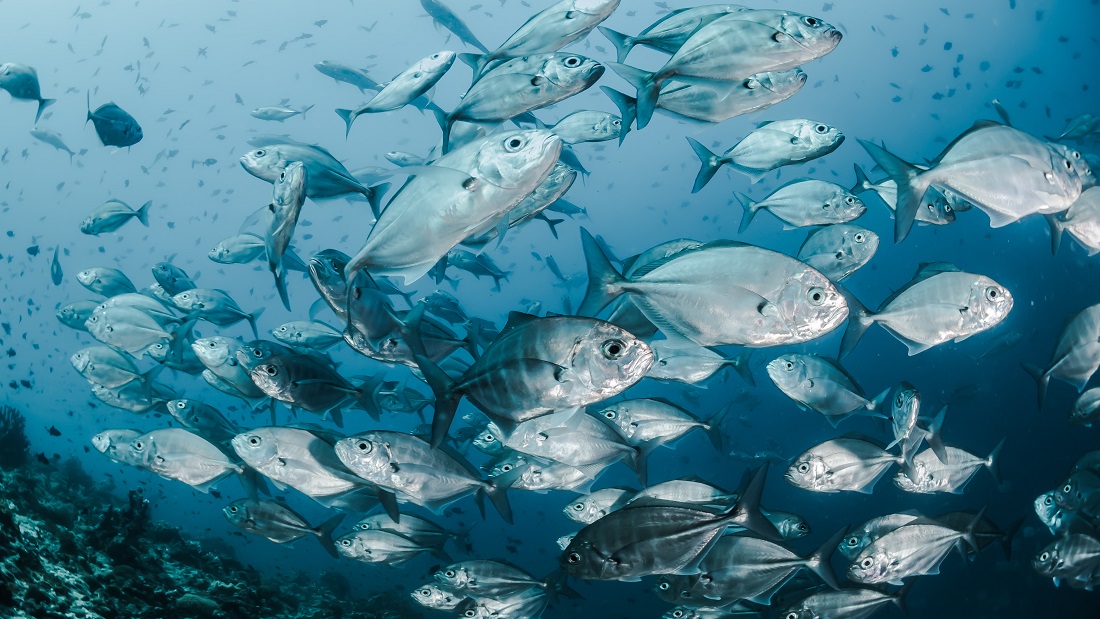
There are two types of commercial fish production – capture fishing (wild caught species from oceans, seas, rivers and lakes) and aquaculture (the farming of fish under controlled salt and freshwater conditions). Fish farming is often touted as the answer to overfishing and yet in reality it exacerbates the problem through its reliance on wild-caught fish to feed farmed fish.
In 2020, global fish production was estimated at 178 million tonnes, of which 90 million tonnes (51 per cent) came from capture fishing while 88 million tonnes (49 per cent) were from aquaculture. Around 20 million tonnes of fish were caught for non-food purposes and were reduced to fishmeal and fish oil, which is still considered the most nutritious and digestible ingredient for farmed fish feeds.1Food and Agriculture Organisation of the United Nations (FAO), 2022. The State of the World Fisheries and Aquaculture. Available at https://www.fao.org/3/cc0461en/cc0461en.pdf [Accessed 7 September 2022].
Human population and fish consumption
The number of fish killed for food are so huge that annual statistics don’t refer to the number of fish slaughtered, just their collective weight. Mood and Brooke2Mood, A., Brooke, P., 2010. ‘Estimating the number of fish caught in global fishing each year’. Fishcount. Available at http://fishcount.org.uk/studydatascreens/frontpage.php [Accessed 28 April 2020]. sought to overcome this by calculating mean individual weight for nearly 70 per cent of fish capture tonnage, reported by the UN Food & Agriculture Organisation (FAO). They estimated that every year between 0.97 to 2.74 trillion wild fish were captured globally.
However, as the data is limited, the estimate excluded fish caught illegally; fish caught as bycatch and discarded; fish that die following escape from nets; fish killed by accident with ‘ghost nets’; fish caught for the fishers own use as bait but not recorded; fish caught for use as feed, either whole or chopped, on fish and shrimp farms but not recorded; and all other unrecorded or unreported capture.3Mood, A., 2010. ‘Worse things happen at sea: the welfare of wild-caught fish’. Fishcount. Available at http://fishcount.org.uk [Accessed 28 April 2020].
Between 1961 and 2016, the average annual increase in global fish consumption (3.2 per cent) outpaced population growth (1.6 per cent) and exceeded that of meat from all terrestrial animals combined (2.8 per cent).1Food and Agriculture Organisation of the United Nations (FAO), 2018. The State of the World Fisheries and Aquaculture. Available at http://www.fao.org/3/i9540en/I9540EN.pdf [Accessed 28 April 2020].
In 2018 (latest figures available at time of writing), British fishing vessels landed 698,000 tonnes of sea fish, both locally and abroad, with a value of £989 million (GBP).4Gov.uk, 2019. Fishing industry in 2018 statistics published. Available at https://www.gov.uk/government/news/fishing-industry-in-2018-statistics-published [Accessed 23 May 2020].
Types of commercial capture fishing
The total number of fishing vessels in the world in 2016, from small undecked and unmotorised boats to large sophisticated industrial vessels, was estimated to be about 4.6 million. Unsurprisingly, the Asian fleet accounts for about 75 per cent of the global fleet with 3.5 million vessels.1Food and Agriculture Organisation of the United Nations (FAO), 2018. The State of the World Fisheries and Aquaculture. Available at http://www.fao.org/3/i9540en/I9540EN.pdf [Accessed 28 April 2020].
Trawlers:
Trawlers typically tow a funnel-shaped net behind them – from either one or two vessels in ‘pair trawling’ – and chase fish to exhaustion. The main target is demersal fish – those that live on or near the bottom of the ocean such as cod, haddock, whiting, soles – rather than pelagic fish that live in open water.
While the trawl is set, the mouth of the net is held open by a pair of heavy, metal-bound trawl doors (otter boards) that either drag along the sea floor or just above. Once the net has been towed for a set time it is hauled out of the water and the fish cascade on to the deck for processing.
The great majority of marine animals live in, on, or immediately above the seafloor and bottom trawling causes profound damage to marine ecosystems, which in the deeper oceans are fragile and slow growing. The UN Environment Programme’s report, Cold-Water, Coral Reefs, states that: “Undoubtedly, the greatest and most irreversible damage is due to the increasing intensity of deep-water trawling that relies on the deployment of heavy gear which ‘steamrollers’ over the sea floor”.5Freiwald, A., Helge Fossa, J., Grehan, A., Koslow, T. and Murray Roberts, J., 2004. ‘Cold-water coral reefs, out of sight – no longer out of mind’. United Nations Environment Programme. Available at https://wedocs.unep.org/bitstream/handle/20.500.11822/8727/Cold_water_coral_reefs.pdf [Accessed 29 April 2020].
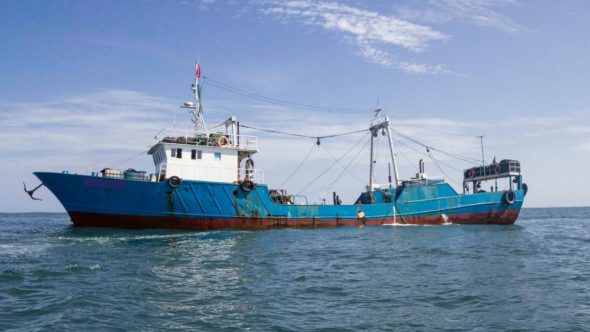
Photo: Alejandra Gimeno-Potter
Long-liners:
In long-line commercial fishing, thousands of hand-baited hooks hang from branch lines attached to a single lead line and are cast out to sea. Depending on the target species, they’re then either anchored to the sea floor (demersal longlining) or left to drift (pelagic longlining).
The lines of commercial vessels can run over 100 km and exceed depths of 1,500 metres and as such radio beacons, along with marker buoys, are used to help the crew to locate the lines they have laid.
The length of hook-studded longlines set every night in our seas is enough to wrap around the world 500 times over.6Roberts, C., 2012. Ocean of Life. UK: Penguin Press. Launched in 2013 the Alaskan super-fishing vessel, Northern Leader, has the capacity to bait up to 76,800 hooks per day. Much shorter long lines are used in in-shore fisheries over rocky seabeds that are unsuitable for trawling.
Long lining is commonly used to target ground fish such as sable, cod or halibut (demersal) whereas it is more common to catch swordfish or tuna with pelagic longlining but of course, non-targeted species are inevitably caught in the process.
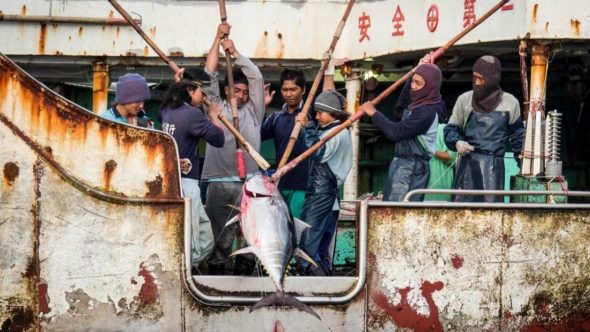
Photo: Simon Ager
Purse seiners:
Purse seine fishing employs a long wall of netting towed in a circle called a seine. It hangs vertically in the water with its bottom edge held down by weights and its top buoyed by floats. At the bottom of these nets there are several steel rings, which a line passes through. Once pulled the net closes – like a draw-string purse.
These nets have the capacity to scoop up entire schools of fish in a single set. On an industrial purse seiner these nets are approximately 2 km in length and can reach 200 metres below the surface – six times deeper than the recreational dive limit.
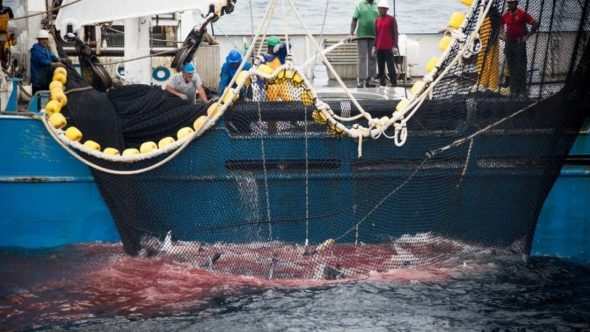
Photo: Simon Ager
Fish welfare
In their attempts to escape the nets, fish regularly cause themselves scale damage by thrashing against the sides of the net or colliding with other fish. Some suffocate as a result of the crushing weight of the rest of the fish trapped in the net with them. As the nets are lifted to the surface from deep water, many fish experience decompression injuries, such as burst swim bladders.4Mood, A., 2010. ‘Worse things happen at sea: the welfare of wild-caught fish’. Fishcount. Available at http://fishcount.org.uk [Accessed 28 April 2020].
Fish caught on hooks often become the prey of predatory fish, who attack them in their hunt for an easy meal. Bait on long-lines also catches the eye of sea birds who dive in to feed and become hooked or entangled in the line and drown.
Overfishing
Overfishing refers to when more fish are caught than can be replaced through natural reproduction. Based on the assessment that if the catch of an individual species declines to less than 10 per cent of its previous maximum, a fishery is considered collapsed.7Hilborn, R., 2012. Overfishing What Everyone Needs to Know. US: Oxford University Press.
It is often quoted that global fish ‘stocks’ will run out by 2048, due to a study published in 2006. However, this was later overturned by the original authors in another paper, focusing on increasing efforts to restore marine ecosystems and rebuild fisheries. The research concluded that 63 per cent of assessed fish stocks worldwide require rebuilding, and even lower exploitation rates are needed to reverse the collapse of vulnerable species.
The number of fish stocks facing serious depletion has been accelerating for decades. Up to 90 per cent of all large predatory fish such as cod, shark, halibut, grouper, tuna, swordfish and marlin, have been diminished, which scientists conclude has potentially serious consequences for eco-systems.8Myers, R. and Worm, B., 2003. ‘Rapid Worldwide Depletion of Predatory Fish Communities’. Letters to Nature 423 15 May. Available at http://seismo.berkeley.edu/~manga/eps3/myersandworm2003.pdf [Accessed 28 April 2020].
Fish species are unable to cope with the pressure caused by increasing consumer demands for seafood and the fragile marine ecosystems, upon which our planet depends, are disrupted. The introduction of fishing quotas, bag limits, licensing, closed seasons, size limits and marine reserves has done little to remedy the problem.
As popular fishing grounds nearest to developed countries dwindle, fishing fleets have pushed further afield to the waters of developing nations, where more than half of all fish exports now originate. As a result, seafood has become one of the most traded food commodities worldwide. In 2016, about 45 per cent of global fish production entered international trade in various forms for human consumption or non-edible purposes.1Food and Agriculture Organisation of the United Nations (FAO), 2018. The State of the World Fisheries and Aquaculture. Available at http://www.fao.org/3/i9540en/I9540EN.pdf [Accessed 28 April 2020].
The notion that fisheries are exhaustible is something that has been understood since 1900.7Hilborn, R., 2012. Overfishing What Everyone Needs to Know. US: Oxford University Press. Yet despite a few examples of depleted fish populations making a slight comeback (eg Newfoundland cod), there remains a lack of political will and, in some cases, economic power to successfully conserve and protect vulnerable species. Consumer power is required to drive change – it is vital we choose to avoid eating fish.

Illegal Fishing
Aside from the mismanagement of legal fisheries and the increase in pollution, our oceans are also under assault from illegal, unreported and unregulated (IUU) fishing. These unscrupulous poachers take advantage of enforcement vacuums on the high seas (the wild west of fishing grounds), corrupt administrations in poorer states and weak management regimes that lack effective monitoring, control and surveillance. It’s modern day piracy and it’s highly profitable.
It’s thought that today, one in three fish imported into the US are caught illegally or through the exploitation of regulations.9Pramod, G., Nakamura, K., Pitcher, T. and Delagran, L., 2014. ‘Estimates of illegal and unreported fish in seafood imports to the USA’. Marine Policy 48 September. Available at https://www.sciencedirect.com/science/article/pii/S0308597X14000918 [Accessed 28 April 2020]. While illegal fishing directly violates national and international laws, unreported fishing refers to misreported or underreported catch and bycatch figures, and unregulated fishing refers to areas without specific management measures in place.
Our oceans are vast, and it is almost impossible to effectively regulate the fishing industry. Potential profits from pushing the boundaries are high and much of it is done out of sight. The scale of destruction and the widespread suffering of marine wildlife is almost entirely hidden from view – even more than the industrialised sheds of factory farms on land.
In 2012, it was estimated that 78 per cent of the global fish catch failed to meet sustainable targets – ships were catching more than the oceans could sustain. But that was just the ‘reported’ fish catch and the FAO reckons that illicit fishing may account for up to 26 million tonnes of fish a year.10World Ocean Review, 2013. ‘The Future of Fish – The Fisheries of the Future’. World Ocean Review 2. Available at https://worldoceanreview.com/en/wor-2/ [Accessed 28 April 2020].
Bycatch
Whether fish are caught via trawl nets, long-lines or purse seines, bycatch is inevitable. Industrial fishing is indiscriminate. The wrong species, the wrong sizes and even the wrong sexes are incidentally caught in the process so that wherever there is fishing, there is bycatch. The unwanted fish are mostly thrown overboard, dead or dying – including supposedly protected and endangered species.
Around 300,000 small whales, dolphins and porpoises die from entanglement in fishing nets across the globe every year,11Read, A., Drinker, P. and Northridge, S., 2006. ‘Bycatch of Marine Mammals in US and Global Fisheries’. Conservation Biology 20 (1) pp.163-169. but due to underreporting, and the practice of ‘high-grading’ – when low-value fish are dumped at sea and replaced with fish of a higher value – the number of deaths is likely to far exceed total fish production estimates.
Catch of some species often go unrecorded and are dismissed as bycatch. Fish discards are a huge problem and the FAO estimates that about eight per cent of all fish caught are thrown back – dead or dying – the equivalent of about three billion Atlantic salmon per year.12Food and Agriculture Organisation of the United Nations (FAO), 2017. ‘Losses in fisheries and aquaculture tackled at Global Fishery Forum’. Global Fisheries Forum & Seafood Expo 2017. Available at http://www.fao.org/europe/news/detail-news/en/c/1037271/ [Accessed 26 May 2020].
Aquaculture
In response to the global decline of ‘fish stocks’, aquaculture has become the world’s fastest growing food production sector, generating around 47 per cent of all the fish consumed1Food and Agriculture Organisation of the United Nations (FAO), 2018. The State of the World Fisheries and Aquaculture. Available at http://www.fao.org/3/i9540en/I9540EN.pdf [Accessed 28 April 2020].; and yet, in order to sustain its growth, it is heavily reliant on the capture of wild-caught fish.
There are a diverse range of fish species farmed in the UK – carp, sea bass, salmon, trout and tuna – that are housed in a variety of extensive freshwater pond or sea cage systems with stocking densities ranging from low to high.
In the UK, we slaughter in excess of 77 million farmed fish annually,13Mood, A., 2017. ‘Estimated numbers of individuals in aquaculture production of fish species’. Fishcount. Available at http://fishcount.org.uk/studydatascreens2/2017/numbers-of-farmed-fish-B0-2017.php?countrysort=United%2BKingdom%2Fsort2 [Accessed 28 April 2020]. making fish the second largest number of farmed animals slaughtered for food, after chickens. The most commonly farmed species is the Atlantic salmon, with around one million salmon meals eaten every day in Britain.14Adams, L., 2019. ‘Is there a problem with salmon farming?’. BBC News 20 May. Available at https://www.bbc.co.uk/news/uk-scotland-48266480 [Accessed 28 April 2020]. But as every pound of farmed salmon consumes around three pounds of wild-caught fish as food, there are far more lives lost.15Gross, L., 2008. ‘Can Farmed and Wild Salmon Coexist?’. PLoS Biology 6 (2) e46. Available at https://journals.plos.org/plosbiology/article?id=10.1371/journal.pbio.0060046 [Accessed 28 April 2020].
Scotland is the largest producer of Atlantic salmon in the EU and the third largest global producer, with an industry worth over £2 billion (GBP).16Kenyon, W. and Davies, D., 2018. ‘Salmon Farming in Scotland’. The Scottish Parliament Briefing 13 February. Available at https://digitalpublications.parliament.scot/ResearchBriefings/Report/2018/2/13/Salmon-Farming-in-Scotland [Accessed 28 April 2020]. Of the 250 Scottish farms, around 70 per cent are certified by the RSPCA Assured scheme17Moore, G., 2018. ‘RSPCA dismay at Holyrood salmon inquiries snub’. Fish Farming Expert 7 June. Available at https://www.fishfarmingexpert.com/article/rspca-dismay-at-holyrood-salmon-inquiries-snub/ [Accessed 28 April 2020]. – which would suggest that high welfare standards are implemented and well-monitored. However, that’s simply not the case.
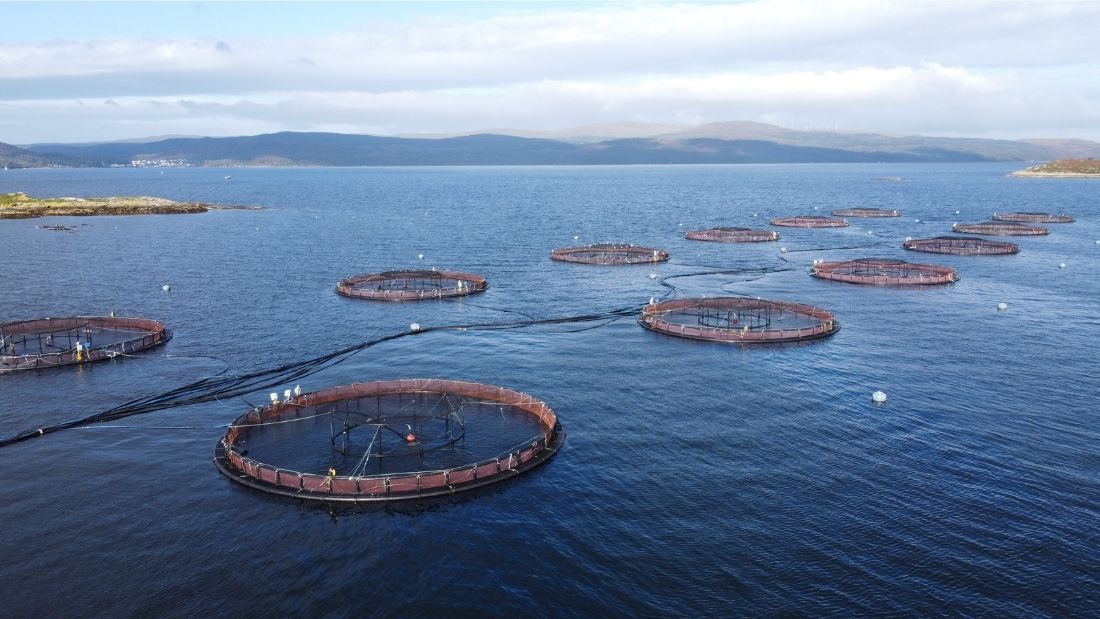
Disease and illness in fish farms
Much like land-based factory farms, the conditions on fish farms are unable to replicate the complexities of an animal’s natural environment and, as a result, fish also suffer from a range of serious welfare issues in much the same way as land animals. Stocking densities are the biggest problem fish farms face as they either pack too many or too few individuals into dirty pond systems or sea cages.
Due to their lateral lines – a system of sense organs located in their heads and along both sides of their bodies and used to detect movement and vibration in the surrounding water – fish rarely like touching each other. High stocking densities create stressful environments in which fights regularly break out, causing fin damage and abrasions. Low stocking densities often mean that fish are more open to predation and therefore feel more threatened.
Both environments are hugely distressing and lead to high mortality rates, poor water quality, disease outbreaks and increased levels of sea lice, which negatively impact the surrounding environment and wild fish populations.18BBC Radio 4, 2020. ‘Atlantic Wild Salmon: A Fish Crisis’. The Food Programme 24 February. Available at https://www.bbc.co.uk/programmes/m000fnkv [Accessed 23 April 2020].
Not only are fish farms unsustainable, they transmit disease and foul coastal waters with a long list of organic and chemical contaminants, including faeces that choke marine life, surplus feed laden with additives, antibiotics, pesticides, toxic antifouling paints and disinfectants.15Gross, L., 2008. ‘Can Farmed and Wild Salmon Coexist?’. PLoS Biology 6 (2) e46. Available at https://journals.plos.org/plosbiology/article?id=10.1371/journal.pbio.0060046 [Accessed 28 April 2020].
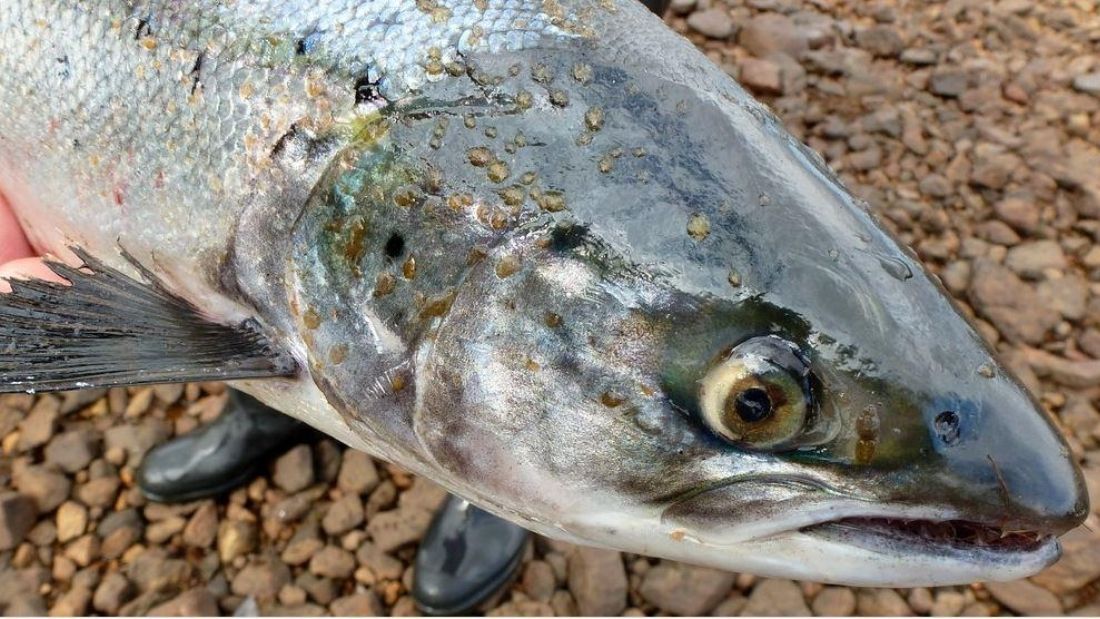
Traditionally, both capture and farmed fishing practices, kill fish by asphyxiation – a slow, painful and distressing death as they’re starved of oxygen, whether in the open air or placed on ice. Little or no consideration is given to their welfare, even though we know fish can experience fear and feel pain.1Braithwaite, V., 2010. Do Fish Feel Pain? Oxford: Oxford University Press. Farmed fish also endure excessive periods of starvation and stressful transportation before being inhumanely killed.2Lines, J. and Spence, J., 2014. ‘Humane harvesting and slaughter of farmed fish’. Revue Scientifique et Technique 33 (1) pp 225-64. Available at https://doc.oie.int/seam/resource/directMedia/soItVRmBti9zNqRz4kY7-PGq-s-3K1Ao;jsessionid=a890c530565a58bc27548c99bda8?binaryFileId=11693&cid=519 [Accessed 30 April 2020].
Types of commercial slaughter methods include:
- Asphyxiation in air or on ice (carp, seabream, seabass, trout, turbot)
- Asphyxiation followed by percussive stun (carp)
- Carbon dioxide stunning (salmon, trout)
- Live chilling (carp, salmon, seabream, seabass, trout)
- Gill-cutting without prior stunning and allowing the fish to bleed to death (turbot)
- Immersion in salt and gutted while likely still to be alive (eel).
The commercial method of slaughtering carp involves the fish being removed from water for 20 minutes or longer before being percussively stunned with a ‘priest’ – a metal or wooden club.3Mood, A., 2012. ‘Slaughter of Farmed Fish’. Fishcount. Available at http://fishcount.org.uk/farmed-fish-welfare/farmed-fish-slaughter [Accessed 30 April 2020].
According to the European Food Safety Authority, ’many existing commercial killing methods expose fish to substantial suffering over a prolonged period of time […] For many species, there is not a commercially acceptable method that can kill fish humanely’.4Humane Slaughter Association (HSA), 2018. ‘Humane slaughter of finfish farmed around the world’. Humane Slaughter Association Report. Available at https://www.hsa.org.uk/downloads/hsafishslaughterreportfeb2018.pdf [Accessed 30 April 2020].
In the European Union, legislation supposedly protects fish at slaughter on the general principle of avoiding suffering. Percussive or electrical stunning systems are recommended by the World Oganisation for Animal Health and the European Food Safety Authority to ensure slaughter is carried out ‘humanely’.5Boyland, N. and Brooke, P., 2017. ‘Farmed fish welfare during slaughter’. Aquaculture Advisory Council September. Available at https://www.aac-europe.org/images/Slaughter_report__AAC_report.pdf [Accessed 30 April 2020].
So-called ‘humane slaughter’ practices include:
- Percussive and electrical stunning machines
- Percussive stunning with a club
- Spiking the brain
- Spiking combined with food-grade fish sedatives.
However, to achieve these aims, methods must be properly designed for the species in question and effectively carried out.3Mood, A., 2012. ‘Slaughter of Farmed Fish’. Fishcount. Available at http://fishcount.org.uk/farmed-fish-welfare/farmed-fish-slaughter [Accessed 30 April 2020]. At present, there are no targeted requirements on permissible killing methods for fish, yet supermarkets in the UK have reportedly adopted ‘humane slaughter’ standards for salmon and trout under The Soil Association6The Soil Association, 2017. ‘Organic aquaculture standards’. The Soil Association Version 1.3 May. Available at https://www.soilassociation.org/media/15726/soil-association-aquaculture-standards-v1-3-may-2017.pdf [Accessed 30 April 2020]. and RSPCA Assured7RSPCA, 2018. ‘RSPCA welfare standards for farmed Atlantic salmon’. RSPCA Assured February. Available at https://science.rspca.org.uk/documents/1494935/9042554/RSPCA+welfare+standards+for+farmed+Atlantic+salmon+%28PDF+2.56MB%29.pdf/60ae55ee-7e92-78f9-ab71-ffb08c846caa?t=1557668417384 [Accessed 30 April 2020]. food standards schemes.
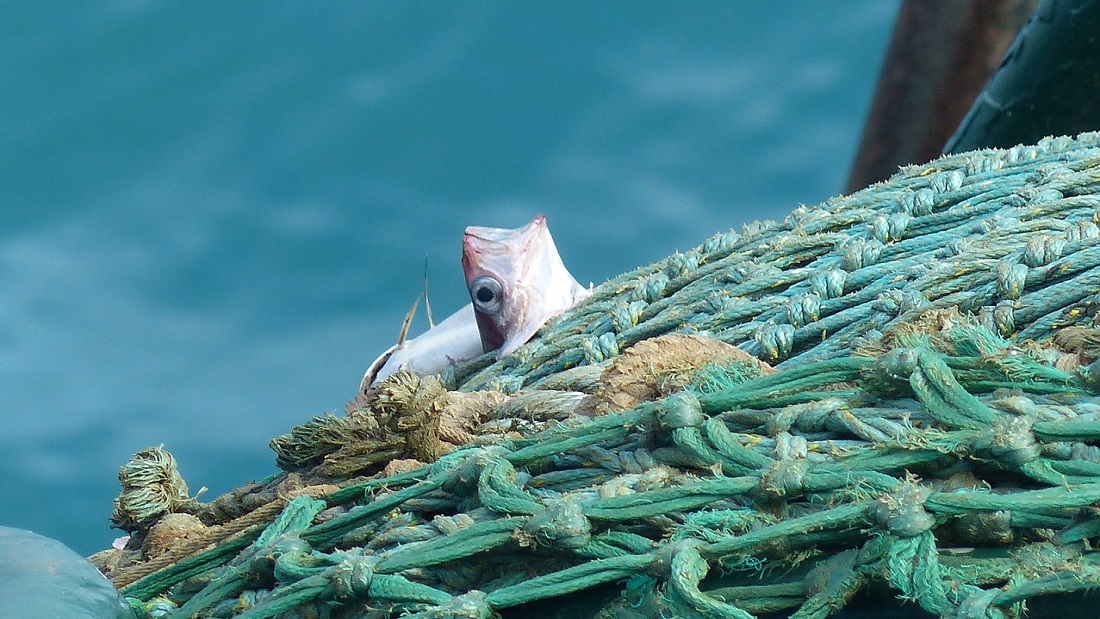
Fish Feel Pain
Suggested caption: “The question is not ‘can they reason?’, nor ‘can they talk?, but ‘can they suffer?’ – Jeremy Bentham. It has been scientifically proven fish feel pain like all other animals. They often meet a painful death through suffocation before ending up on your plate. Choose the kinder option and choose vegan!
Does This Look Humane to You?
Suggested caption: Fish meet a painful death by suffocation, and often thrash so violently they tear their own muscles while they fight for breath. Studies show fish feel pain like all other animals and no animal wants to die. Does this sound humane to you?




